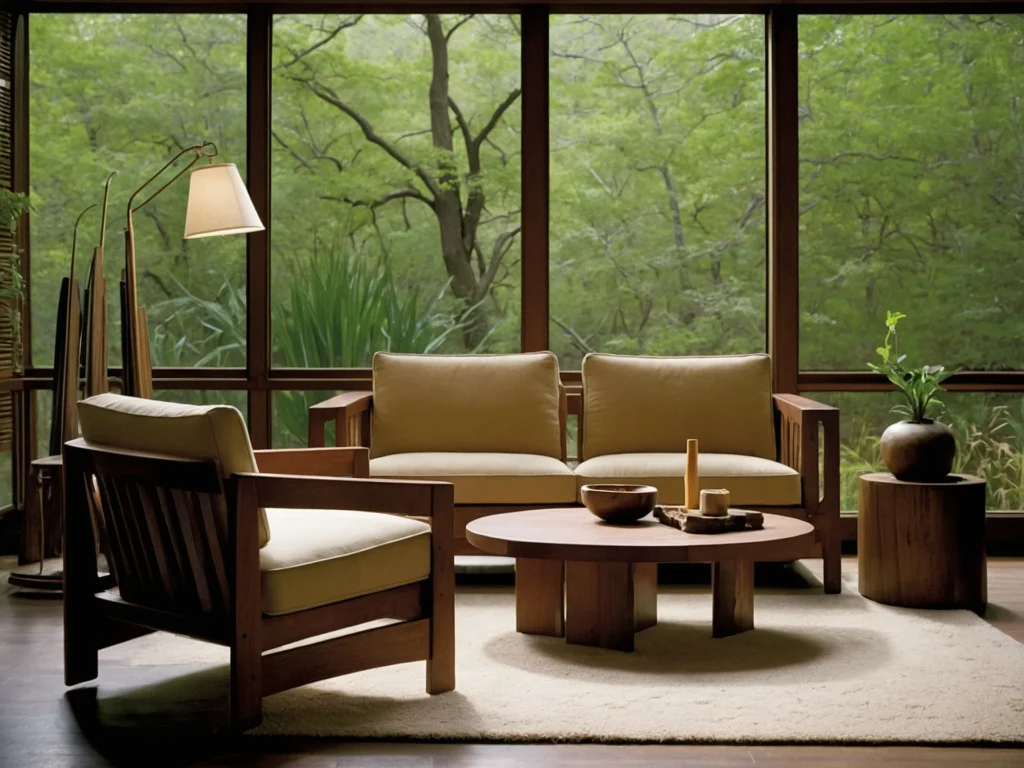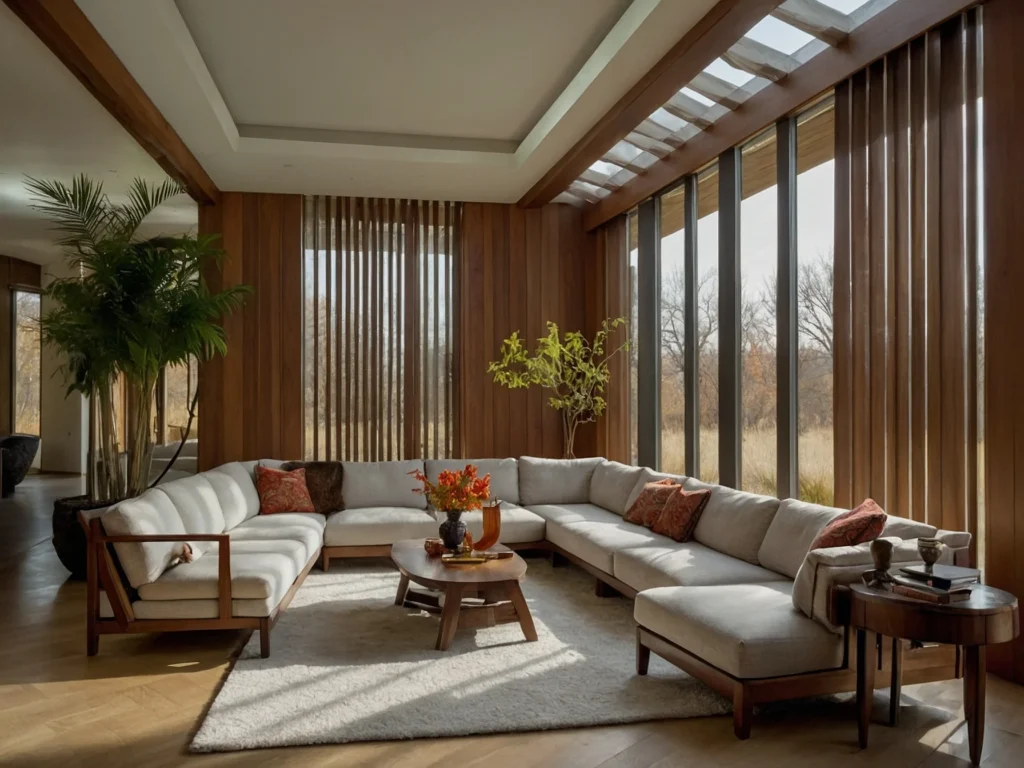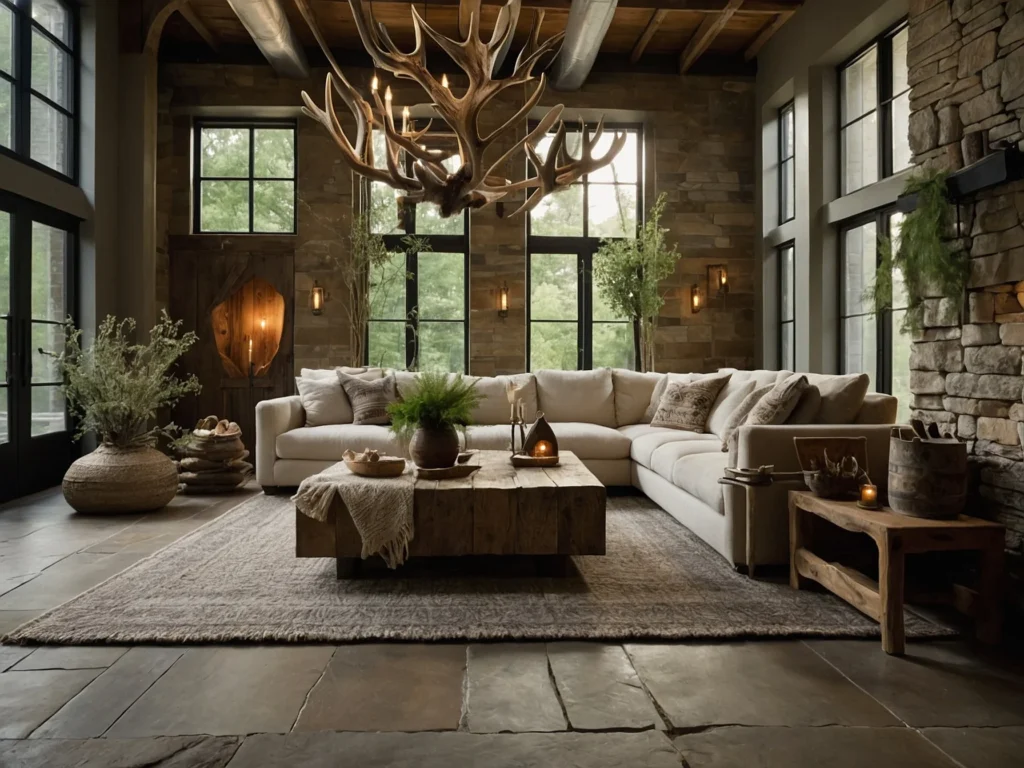Prairie Style furniture, with its emphasis on simplicity, functionality, and connection to nature, has experienced resurgent popularity in recent years. This distinctly American design movement remains as relevant today as it emerged over a century ago.

Overview of Prairie Style Furniture
Prairie Style furniture is characterized by:
- Horizontal lines
- Flat planes
- Built-in and modular furniture
- Use of natural materials like wood, stone, and fabrics
- Neutral earth tones
- Simplicity and functionality
The style evokes the horizontality of the expansive Midwestern prairie landscape. It integrates interior architecture with furnishings, blurring the line between functional furniture and architectural details.
Prairie Style emerged in the late 19th and early 20th century under architects like Frank Lloyd Wright who designed homes featuring open floor plans and ample natural light. Furniture makers like Gustav Stickley created furnishings to complement these architectural ideals.
Beyond Wright, other prominent architects and designers who contributed to Prairie Style include George Grant Elmslie, William Gray Purcell, George Washington Maher, and the design collective Associated Artists. Furniture makers Gustav Stickley, the Roycrofters, Harvey Ellis, and the L. & J.G. Stickley company were integral in translating the architecture into furnishings.
This distinctly American take on the Arts and Crafts movement emphasized simplicity, function, and harmony between furniture and interior architecture. It rejected the over-ornamentation and clutter of the Victorian era in favor of clean lines and forms.
Key Design Elements of Prairie Style Furniture

Prairie Style furniture is a testament to the harmony between design and the natural environment, a philosophy that is deeply rooted in the broader Prairie School movement. This design ethos is characterized by several key elements that work together to create a distinctive and timeless aesthetic:
Horizontal Lines

The vastness of the prairie landscape is mirrored in the horizontal lines that are a hallmark of Prairie Style furniture. These lines are not just a design choice; they are a nod to the natural expansiveness of the Midwest plains. Furniture pieces often feature long planks, wide bands, and elongated details that draw the eye sideways, emphasizing the width and flow of the pieces, much like the horizon line does in nature.
Rectilinear Shapes

The use of rectilinear shapes is another defining characteristic. Squares, rectangles, and cubes are prevalent, creating a sense of stability and order. This geometric precision is evident in the structured table tops, the straight-backed chairs, and the orderly shelving units, all of which contribute to a sense of calm and balance.
Natural Materials

Wood, especially oak, features prominently since it inherently brings a touch of nature indoors. Textiles tend toward natural fibers like linen, cotton, and wool in solid earth tones. Leather and rawhide add warmth. Stone like granite provides durability.
Built-in Furniture

In Prairie Style furniture, the choice of materials is paramount. Oak is a favored wood due to its durability and the ease with which it can be worked into the desired forms. The grain of the wood is often left exposed, celebrating its natural patterns and textures. Textiles are chosen for their natural qualities as well, with linen, cotton, and wool in earthy tones complementing the wood. Leather and rawhide are used to add warmth and tactility, while stone accents provide a sense of solidity and permanence.
Simplicity

Simplicity is a virtue in Prairie Style furniture. There is a deliberate avoidance of excessive ornamentation. The focus is on clean lines and plain surfaces, allowing the materials themselves to take center stage. This simplicity is not merely aesthetic; it is a reflection of the philosophical underpinnings of the Prairie School, which valued authenticity and purity of design.
Modularity

Modularity in Prairie Style furniture offers a practical aspect to the design, allowing for flexibility and customization. Components such as shelves, seats, and tables can be arranged to suit the needs of the space and the preferences of the user.
Comfort

Despite its strong geometric lines and solid construction, Prairie Style furniture is designed with comfort in mind. Cushions and pillows soften the straight lines and provide a welcoming touch.
A Wider Prairie School Movement

Beyond furniture, Prairie Style encompassed a broader American design movement popular between 1900-1920. It included residential architecture, textiles, ceramics, lighting, and metalwork. While varied, the shared traits of simplicity, handcraftsmanship, and connection to nature unified the movement.
Many point to Frank Lloyd Wright’s Robie House in Chicago as the seminal Prairie Style building. But the movement spread rapidly and transformed architecture and furnishings across the Midwest and beyond.
History and Origins of Prairie Style Furniture
Prairie Style furniture has its roots in the American Arts and Crafts movement (1880-1910). It evolved as a regional variant tailored to the Midwest rather than just mimicking the English or coastal versions of Arts and Crafts.
Arts & Crafts Movement Origins
The Arts & Crafts movement originated in England as a response to the negative impacts of industrialization. Led by designer William Morris, it called for a return to traditional craftsmanship and simple forms. Natural materials and a connection to nature were paramount.
The influential philosophy and architecture of Morris and John Ruskin gained popularity in America thanks to efforts of figures like Elbert Hubbard, Gustav Stickley, and Frank Lloyd Wright. Handicraft guilds like the Roycrofters emerged to embody Arts & Crafts ideals.
Prairie School – Blending Architecture and Interior Design
Architect Frank Lloyd Wright studied under Louis Sullivan whose philosophy of “form follows function” and emphasis on simplicity exerted a profound influence.
Wright broke away from revivalist Victorian traditions and began designing homes utilizing open floor plans, ample light, and built-in furnishings – a revolutionary departure at the time. The long horizontal lines and natural materials harmonized with the flat Midwestern landscape.
Furniture makers like the Roycrofters and Stickley interpreted Wright’s architectural principles into furnishings like modular bookcases and settles that integrated seamlessly into these new modernist homes.
Gustav Stickley – Leading Furniture Designer
Gustav Stickley was undoubtedly the most prominent Prairie Style furniture designer. Through his Craftsman Workshops and the magazine The Craftsman, Stickley disseminated Prairie Style widely to American homes in the early 20th century.
Stickley struck a balance between utility and understated beauty in his furniture. His trademark techniques like mortise and tenon joinery showed off the craftsmanship. Inexpensive but durable woods like white oak suited his populist vision that well-designed furniture should be accessible to all.
Stickley later partnered with his brothers Leopold and John George to form L. & J.G. Stickley company which remains one of the most enduring American furniture manufacturers.
Prairie Style Furniture in the Modern Home
While born of turn-of-the-century Midwestern sensibilities, Prairie Style furniture retains enduring, universal appeal making it well-suited for 21st century living:
Practicality and Durability
The functionality and craftsmanship result in furniture built to last through generations of everyday use. These pieces exhibit a practical durability suitable for family living.
Warmth and Invitation
The natural materials and textures create a warm, inviting environment in contrast to the sterility of some contemporary decor. The livable quality makes it comfortable yet visually interesting.
Intentionality and Mindfulness
The simplicity inspires a paring down to essentials. This mindfulness translates well to modern minimalist living. The modular flexibility also facilitates rearranging to suit changing needs.
Sustainability
The focus on durable, natural materials and craftsmanship results in furniture that can be repaired and refinished rather than replaced. This inherent sustainability appeals to eco-conscious consumers.
Unique American Style
Unlike some other furniture styles, Prairie Style is distinctly American in origin. It forgoes revivalism in favor of an aesthetic tailored to American spaces and sensibilities.
Notable Prairie Style Furniture Makers: Past and Present
While Gustav Stickley’s designs dominate most perceptions of Prairie Style, several other designers and craftsmen have carried the aesthetic forward over the past century in original ways:
Gustav Stickley (1858-1942)
As the figurehead of the Craftsman movement, Stickley exerted enormous influence over Prairie Style in America through his furnishings, workshops, and magazine.
The Roycrofters
This collective led by Elbert Hubbard was part of the American Arts and Crafts movement. Roycroft furniture strongly embodied Prairie Style.
Greene & Greene
Brothers Charles Sumner Greene and Henry Mather Greene designed influential California bungalows and furnishings in a blend of Prairie Style and Asian aesthetics.
L. & J.G. Stickley
The Stickley brothers carried on Gustav Stickley’s legacy and grew the family business into the longest enduring high-end American furniture company.
William Morris (1834-1896)
The prominent English designer helped inspire the international Arts & Crafts movement which heavily influenced American Prairie Style.
Frank Lloyd Wright (1867-1959)
Wright’s Prairie Style architecture and the notion of organic architecture provided the context for signature furniture design.
George Washington Maher (1864-1926)
His architecture promoted simplicity and eliminating unnecessary ornamentation, principles which aligned with Prairie Style ideals.
Harvey Ellis (1852-1904)
Ellis’ furnishings epitomized Prairie Style in their simplicity and craftsmanship working for both Gustav Stickley and the Roycrofters.
Contemporary Prairie Style Furniture Makers
The Prairie Style continues to inspire woodworkers and designers today who give the aesthetic a fresh, modern twist:
- Luke Barton – Barton Design: Based in Michigan, Barton crafts custom tables, beds, and other furniture combining rustic elements and clean lines.
- Buchanan Studio – Charles Buchanan: These Minnesota woodworkers create modern Prairie Style pieces like beds and dining sets evoking the Midwest landscape.
- Nakashima Studio: Continues creating furniture in the spirit of late founder George Nakashima and his contemporary interpretations of Asian-infused Prairie Style.
- Thomas Moser: The Thos. Moser brand carries forward the American modernism tradition through contemporary furniture like their Long Prairie Sofa.
- Amish Furniture Makers: Skilled Amish woodworkers handcraft Prairie Style furniture ranging from authentic reproductions to reimagined modern looks.
- Green Mountain Furniture: This Vermont-based company creates custom Prairie Style furniture with an eco-friendly approach.
- Copeland Furniture: Blends Prairie Style with Scandinavian and Japanese influence in their contemporary furniture crafted in Vermont.
- Hennepin Made: Minnesota brand creating custom Prairie-inspired modern designs like platform beds and consoles.
Prairie Style Furniture Today: Key Pieces and How to Incorporate It
For those seeking to incorporate Prairie Style into their homes today, there are signature pieces to look for along with creative ways to blend the aesthetic with modern elements:
Signature Prairie Style Furniture Pieces

Some key furniture styles to look for:
- Settles – Long backed benches perfect for entryways. Often built-in but can also standalone.
- Limbert Tables – Tables with slatted stretcher bases designed by arts & crafts designer Charles Limbert.
- Bookcases – Modular bookshelves with clean lines were ubiquitous in Prairie Style homes.
- Beds – Low, horizontal platforms with headboards of vertical wooden slats.
- Dining chairs and tables – Look for rectilinear shapes and exposed joinery.
- Desks – Often had roll-top or sliding doors to enclose workspace.
- Rockers – Prairie Style rocking chairs tend toward geometric forms without decorative carvings.
Blending Vintage and New

Mixing old and new creates visual interest. Vintage Gustav Stickley or Roycroft pieces can anchor the room while modern accent furniture provides contrast. Reproduction furniture captures the look for less.
Incorporate Natural Elements

Handwoven rugs, stone surfaces, and greenery help reinforce the organic sensibility. Lighting fixtures made from twigs or antlers also keep with the natural vibe.
Accent Colors

While Prairie Style palettes tend toward earth tones, a pop of accent color on pillows, art, or accessories enlivens the space. Oxblood red or forest green work particularly well.
Modern Updates

While keeping the clean Prairie Style lines, modern updates like metal legs on wood furniture, colorful lacquered finishes, or wire base tables maintain visual lightness.
The linear look provides an adaptable backdrop for both vintage and contemporary furnishings. Keeping finishes, fabrics and colors natural allows the Prairie Style to shine through.
Where to Buy Prairie Style Furniture for Your Home
Prairie Style furniture can be found through a blend of vintage shops, specialty manufacturers, custom furniture makers, and major retailers:
- Vintage shops – Look for Stickley, Roycroft, or other makers from the era. Be prepared to pay a premium for authenticity.
- Etsy – Search Etsy and you’ll find Prairie Style antiques along with modern handmade takes on the classics.
- L. & J.G. Stickley – Continues producing high-end reproductions and adaptations of Gustav Stickley’s iconic Craftsman furniture.
- Amish furniture stores – Many Amish craftsmen produce Prairie Style furniture ranging from reproductions to reinterpretations.
- Thos. Moser – Carries contemporary furniture with Arts & Crafts undertones like the Long Prairie Sofa.
- Crate & Barrel – Offers a selection of Prairie Style livable basics like Parsons dining tables and Elston media consoles.
- Room & Board – Choose from modest pieces like Ranson nesting tables and Marni beds with strong horizontal lines.
Building Your Own Prairie Style Furniture
Part of the appeal of Prairie Style is visible craftsmanship. Building your own allows you full creative control and the chance to work with natural materials first-hand.
Overview of Building Process
The straightforward designs make Prairie Style an approachable style for beginners. Some keys for bringing your designs to life:
- Choose the wood – Oak is traditional but maple, walnut, pine and others also work beautifully.
- Simple joinery – Traditional mortise and tenon joints are iconic but modern wood glue is also very strong.
- Select hardware – Look for wrought iron handles and hinges with straight lines to complement the minimalism.
- Finish naturally – Let the wood grain shine through with clear finishes like beeswax or tung oil. Avoid paints that hide natural textures.
- Consider function – Ensure adequate support, ventilation, and storage space tailored exactly as needed.
Online Resources
Helpful sites to learn processes and get inspired with design ideas:
- Youtube woodworking channels – Here you’ll find everything from tutorials, plans, and demos to inspire your projects. Try channels like Steve Ramsey’s Woodworking for Mere Mortals, The Wood Whisperer, and Jay’s Custom Creations.
- Ana White – This website offers a wide range of DIY furniture plans including many Prairie Style classics like settles, Limbert stool tables, and picture ledge bookcases.
- Etsy Studio – Check out the Furniture section of Etsy’s community for makers to get tips and share work.
- Fine Woodworking – While a paid membership site, Fine Woodworking has a wealth of information on techniques and prairie furniture patterns for reference.
A bit of practice combined with online guidance makes crafting your own Prairie Style furniture an attainable and rewarding challenge.
The Future of Prairie Style
Prairie Style’s lasting appeal and renewed interest makes its future bright. This distinctly American take on furnishing a home will continue inspiring designers, woodworkers, and homeowners.
The timeless combination of beauty and utility means Prairie Style will remain a classic style for generations to come. Increasingly, contemporary designers are reimagining and blending it with modern elements for fresh new interpretations suited to how we live today.
Just as Frank Lloyd Wright and Gustav Stickley adapted historic design concepts for early 20th century American life, today’s artists and furniture makers keep Prairie Style creatively evolving yet rooted in its heritage.
Prairie Style’s simplicity, craftsmanship, and connection to nature promise to continue resonating in our furnishings and architecture. The flat horizons of the Midwest still stretch boundlessly on, and so too does the influence of Prairie Style design.
